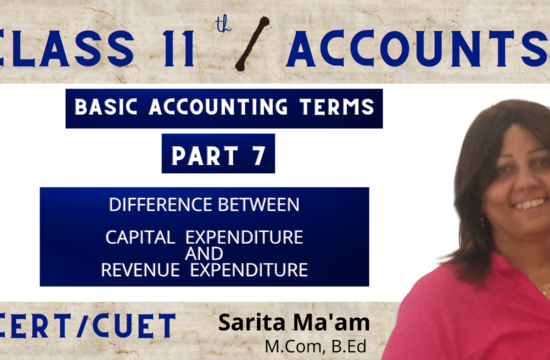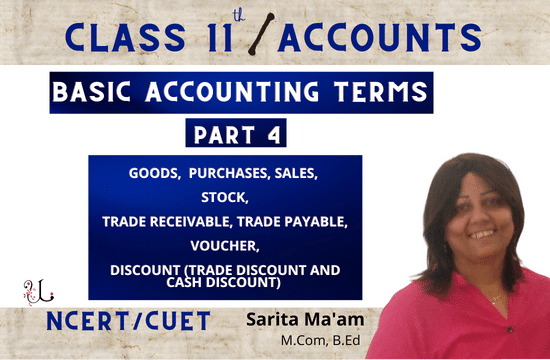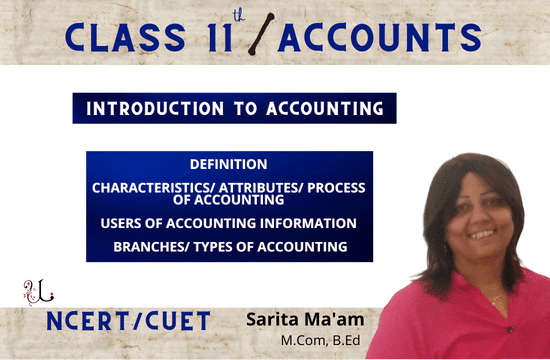Expense:
Expense is the cost incurred for generating revenue (producing goods and services for sell purposes).
According to R.N. Anthony, “Expense is a monetary measure of inputs or resources consumed.”
It is a value which has expired during the accounting period.
Accounting Treatment
An expense is charged (debited) to Trading Account or Profit and Loss Account
Example
- Depreciation i.e. decrease in the value of fixed assets used for the purpose of business is also an expense.
- Amount paid for general business expenses such as salary, rent, wages, advertisement, stationery, etc.
- An amount written off out of Debtors towards bad debt or provision for doubtful debt for the current year is also an expense
- Cost of goods sold
Exercise
Mr. Nikunj Mani dealing in electronic goods sold 20 TV sets costing ₹30,000 each at ₹40,000 each. Out of this ₹ 5,00,000 were received in cash and the balance is not yet received. He paid ₹ 10,000 as salary to his employee. and also received ₹ 5,000 as rent. State the amount of expenses.
SOL
Expenses will be
Cost of goods sold ₹6,00,000 (i.e. 20 sets x ₹ 30,000).
+
Salary ₹ 10,000
Expense ₹ 6,10,000
Prepaid Expense
It is an expense that has been paid in advance and the benefit of which will be available in the following year or years
Accounting Treatment
It will be shown as a Current Asset in the Balance Sheet.
Outstanding Expenses
It is an expense that has been incurred but has not been paid
Accounting Treatment
It is debited to the Profit and Loss Account and also shown under the head Current Liabilities in the Balance Sheet.
Revenue
Revenue is gross inflow of cash (received), receivables arising in the course of ordinary (operating) activities i.e. from the sale of goods, from rendering of services
and
other consideration (non- operating) activities of the enterprise i.e. interest, dividends, rent received, etc.
Thus, revenue is the amount received or receivable by the enterprise from its operating activities and non-operating activity during an accounting year.
- Operating activities: Operating activities are the daily activities of a company involved in producing and selling its product, generating revenues.
- Non-Operating activities: Non-operating activities is the portion of an organization’s income that is derived from activities not related to its core business operations. It can include items such as dividend income, profits, or losses from investments,
Non-operating income is also referred to as incidental or peripheral income.
Revenue from Operations (Sales) + Other Revenues
Revenue from Operations (Sales)
credit sale + cash sale
Other Revenues
Received + Receivable
Examples of revenue are receipts from sale of goods, rent received, commission earned, interest earned, royalty earned, dividend earned
Note capital introduced by proprietor and loan taken is not Revenue
Exercise
Mr. Nikunj Mani dealing in electronic goods sold 20 TV sets costing ₹30,000 each at ₹40,000 each. Out of this ₹ 5,00,000 were received in cash and the balance is not yet received. He paid ₹ 10,000 as salary to his employee. and also received ₹ 5,000 as rent. State the amount of Revenue.
Sol
Revenue will be
Revenue from Operation(sales)
₹8,00,000 (i.e. 20 sets x ₹ 40,000).
+
Rent ₹ 5,000
Total Revenue = ₹8,05,000
Revenue is the amount either received (cash sales) or receivable (credit sales) from the sale of goods and services.
Both operating and non-operating are included in revenue.
Profit= (Total Revenue – (All Expenses & Loss)
Exercise
Mr. Nikunj Mani dealing in electronic goods sold 20 TV sets costing ₹30,000 each at ₹40,000 each. Out of this ₹ 5,00,000 were received in cash and the balance is not yet received. He paid ₹ 10,000 as salary to his employee. and also received ₹ 5,000 as rent. State the amount of Profit.
Sol
Revenue from Operation(sales)
₹8,00,000 (i.e. 20 sets x ₹ 40,000).
+
Rent ₹ 5,000
Total Revenue = ₹8,05,000
Cost of good sold ₹6,00,000 (i.e. 20 sets x ₹ 30,000).
+
salary ₹ 10,000
expense ₹ 6,10,000
Profit (Total Revenue – (All Expenses & Loss)
Profit ₹8,05,000 – ₹6,10,000
₹1,95,000
We calculate profits at two levels
Gross Profit: Gross Profit is the difference between revenue from sales and/or services rendered and its direct cost.
Gross Profit= Revenue from Sale – Direct Expenses (cost of Goods sold + factory related expenses)
Net Profit: Net Profit is the profit after deducting total expenses from total revenue of the enterprise.
Net Profit= (Revenue + Gain) – (Expenses & Loss)
Net Profit= Gross Profit + other Incomes – Indirect Expenses (office related expenses + losses)
Income Income is the amount of profit earned during an accounting period.
It is expressed as—
Income = Revenue – Expense
Income = Net Profit – dividend
Example of Income
Problem
Goods costing ₹25,000 are sold for ₹30,000
SOL
Income = (Revenue – Expense)
REVENUE= ₹30,000
COST OF GOODS SOLD= ₹ 25,000
INCOME= ₹ 5,000
Exercise
Mr. Nikunj Mani dealing in electronic goods sold 20 TV sets costing ₹30,000 each at ₹40,000 each. Out of this ₹ 5,00,000 were received in cash and the balance is not yet received. He paid ₹ 10,000 as salary to his employee. and also received ₹ 5,000 as rent. State the amount of Profit.
Sol
Revenue from Operation(sales)
₹8,00,000 (i.e. 20 sets x ₹ 40,000).
+
Rent ₹ 5,000
Total Revenue = ₹8,05,000
Cost of good sold ₹6,00,000 (i.e. 20 sets x ₹ 30,000).
+
salary ₹ 10,000
expense ₹ 6,10,000
Profit (Total Revenue – (All Expenses & Loss)
Profit ₹8,05,000 – ₹6,10,000
₹1,95,000
Difference between Profit and Income
| Basis | Profit | Income |
| Meaning | Difference between the amount earned and the amount spent in buying, operating, or producing something. | The actual amount of money earned |
| Dependents | Profit is very much dependent on the revenue. | Revenue is very much dependent on both revenue and profit. |
| Indicators | It indicates how much a company has earned over the total cost of sales. | It indicates what amount would be distributed among the shareholders or reinvested in the business |
Gain
Gain is the increase in owner’s equity resulting from something other than the day to day earning from irregular or non-recurring nature:
Stating differently, it is a profit that arises from transactions which are not the Operating Activities of the business but are incidental to it such as gain on sale of land, machinery or investments.
Exercise
During the year, a machinery worth ₹ 3,00,000 was sold for ₹ 3,75,000. State the amount of gain?
Loss
In case total expenses are more than the total revenue, it is Net Loss
Loss is excess of expenses of a period over its revenues. It decreases the owner’s equity.
LOSS
EXPENSES – REVENUE
Exercise
Mr. Nikunj Mani dealing in electronic goods sold 20 TV sets costing ₹30,000 each at ₹25,000 each. Out of this ₹ 5,00,000 were received in cash. He paid ₹ 10,000 as salary to his employee. and also received ₹ 5,000 as rent. State the amount of Loss.
Sol
Revenue from Operation(sales)
₹5,00,000 (i.e. 20 sets x ₹ 25,000).
+
Rent ₹ 5,000
Total Revenue = ₹5,05,000
Cost of good sold ₹6,00,000 (i.e. 20 sets x ₹ 30,000).
+
salary ₹ 10,000
expense ₹ 6,10,000
Loss (Expenses – Total Revenue)
loss ₹6,10,000 – ₹5,05,000
₹ 95,000
It is a broad term and includes loss incurred in its operating (business) activities, money or money’s worth lost against which the firm receives no benefit, e.g., cash or goods lost in theft and loss arising from events of non-recurring nature, e.g., loss on sale of fixed assets.
Exercise
During the year, machinery worth ₹ 3,00,000 was sold for ₹ 2,50,000.
State the amount of loss?
Loss
₹ 50,000
Exercise
1. Revenue from Operations refers to
(a) Revenue earned from Operating Activities.
(b) Revenue earned from activities that are not Operating Activities.
(c) Both (a) and (b).
(d) None of the above.
Answer: (c)
2. Identify the item of Revenue from Operations of a financial enterprise out of the following:
(a) Interest earned on loans (b) Sale of Goods
(c) Services rendered (d) None of these
Answer: (a)
3. Identify the item of Revenue from Operations of a non-financial enterprise out of the following:
(a) Interest earned on loans (b) Sale of Goods
(c) Both (a) and (b). (d) None of these
Answer: (b)

Sarita Chugh M.Com, B.Edan is Accounts and Economics teacher having more than 30+ years of experience. She is Edupreneur and founded Unique Learning Academy in 2004. She believes that every child has the right to affordable education.










